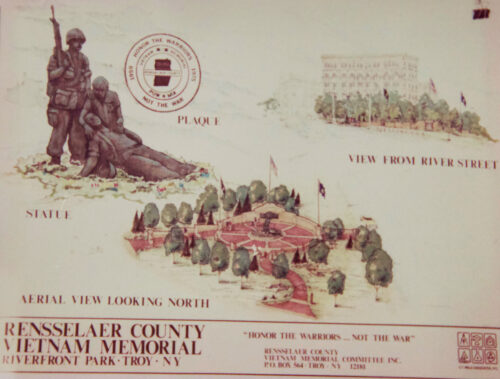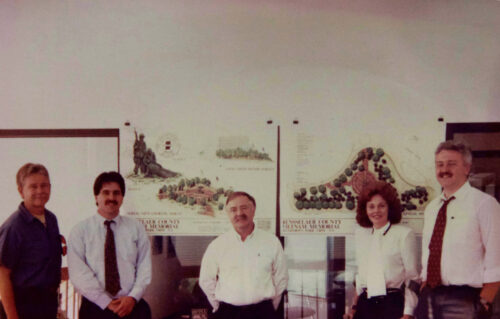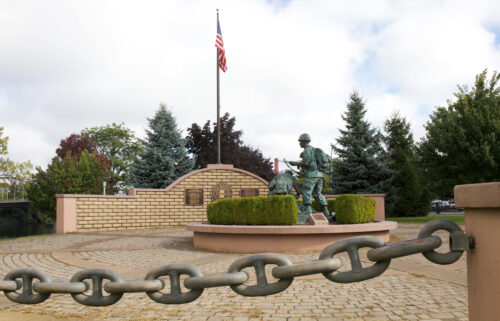A Link in The Story of a Generation’s Redemption, and C.T. Male’s Role in it
 The Rensselaer County Vietnam Memorial sits on the east bank of the Hudson River, in the City of Troy, New York. It is described as “gorgeous” by Jorel Spain, a Wetlands Scientist in C.T. Male’s Environmental Services Division, whose father, James (Jim) Spain, was a founding member of the Rensselaer County Vietnam Memorial Committee. Jim voluntarily signed up to serve, completing two tours in Vietnam as a Marine Corporal, from 1968 to 1969, and saw considerable combat as part of a combined action platoon.
The Rensselaer County Vietnam Memorial sits on the east bank of the Hudson River, in the City of Troy, New York. It is described as “gorgeous” by Jorel Spain, a Wetlands Scientist in C.T. Male’s Environmental Services Division, whose father, James (Jim) Spain, was a founding member of the Rensselaer County Vietnam Memorial Committee. Jim voluntarily signed up to serve, completing two tours in Vietnam as a Marine Corporal, from 1968 to 1969, and saw considerable combat as part of a combined action platoon.
C.T. Male’s relationship to the war memorial resurfaced recently when Mary Anne Ryan, the widow of another committee co-founder, Tim Ryan, unearthed a colored rendering prepared by C.T. Male during the planning stages of the memorial, as she prepared for her move to a new home. Rather than discard it, Mary Anne, a longtime family friend of the Spains, passed it to Jorel, knowing he worked at C.T. Male. Jorel, in turn, brought it to C.T. Male CEO Dave Roecker.
Dave remembered the project, being one of the remaining members of C.T. Male from the 1980s. For him, the rendering spoke to a different time at the firm, in the community and in the country at large. He recognized how meaningful the story of the memorial project would be to our staff, especially the rendering that was an artifact of C.T. Male’s role, and how the rendering found its way back to the firm after nearly four decades.
In order to understand the context of the memorial project, it’s helpful to revisit the huge impact the Vietnam War had on tightly-knit communities the length and breadth of the United States. Like all wars, it upended lives and asked for great sacrifice, often the ultimate sacrifice, from those who served, and brought great pain to their loved ones and their communities. Fought from the mid-60s through the early 70s, it was the last United States war where young men were drafted to serve. And drafted they were, from the largest cities to the smallest towns.
It was also the country’s first televised war. Each evening on the nightly news, American living rooms were subjected to close-ups of the horrors of war, and as the war progressed, many in the country began to ask hard questions.
Why were we losing so many of our youth in battle? Who, or what, was the enemy? What was the point of all this suffering? Since the answers were not always clear, support for the war eroded, culminating in the withdrawal of US troops, and the eventual collapse of the South Vietnamese government they had sought to protect. To a great degree, it was the first war the US was perceived to have lost and many Americans found it easier to forget and move on.
And that had an adverse effect on our veterans. Instead of being welcomed home as heroes, they were forgotten amidst the collective amnesia the nation had developed for Vietnam during the latter half of the 1970s.
The national conversation about the Vietnam War was set aside, for a while.
All that began to change towards the end of the 1970s and into the early 1980s, when the lack of recognition, appreciation, and support for Vietnam veterans became a part of our national discussion. Veterans began to seek recognition of their service. Their activism meant Vietnam could no longer be kept at arm’s length in the nation’s collective conscience, and in 1982, the Vietnam Veterans Memorial was completed in the nation’s capital. It remains the country’s single greatest salute to Vietnam veterans.
But the construction of war memorials didn’t stop there.
Following a veterans’ Welcome Home parade in Chicago in the mid-80s, veteran Jim Davey began to circulate the idea for a memorial in Rensselaer County through local newspapers and by gathering signatures in support of it. A meeting at the Rensselaer County Office Building was organized, and from it the Rensselaer County Vietnam Memorial Committee (RCVM Committee) was formed, with Jim Davey as committee president. Tim Ryan and Jim Spain were both present at this initial meeting.
Jorel grew up amidst a bustle of activities related to the proposed memorial, as his family, along with the other committee members and their families, devoted all their spare time to it. These activities initially included multiple fundraisers. Many such events were attended by celebrities. In one instance, the cast of Tour of Duty, a popular HBO series at the time, marched in a Flag Day parade with the committee.
Once the necessary funds were secured, Eileen Barry, a Long Island based artist and sculptor, was hired to create the memorial statue.
This is where C.T Male comes in. The firm was engaged by the committee as landscape architects to design a park around the statue, at the chosen location in Troy, overlooking the Hudson River. Davey was later to remark that working with C.T. Male had been an extremely pleasant and rewarding experience. The rendering found recently was likely used early in the design process to give the committee and other stakeholders a sense of what the memorial park would look like when completed. It was hand-drawn and colored with markers as was the practice at the time.

The memorial park and central statue are exquisitely designed. Against a backdrop of a wall crafted to resemble a bank of sandbags, there is the poignant statue of three soldiers. One is standing guard, one lies wounded with a third soldier attending to him. The inscription on the statue is ‘Courage, Compassion and Pain’.
On the wall is a plaque with the words ‘Honor the warriors, not the war’, and the names of almost 50 men from the area, either killed or listed as missing in action.
There is a chain partially encircling the statue, which is an actual relic of the combat, the anchor chain for a US destroyer that docked in the Bay of Tonkin. The committee at one time sold links from the chain to raise funds, at $1,000 per link, in a campaign they dubbed the ‘Forty Links Club’.
And encircling the memorial, C.T. Male’s design was brought to reality as a peaceful landscape that allows visitors the space needed to pause and reflect. The City of Troy continues to maintain the park and memorial in pristine condition.
“As the son of one of the founding members of the Rensselaer County Vietnam Memorial Committee,” says Jorel, “I grew up among a tight-knit community of veterans who wanted to do something to honor those who had fought and sacrificed their lives in that conflict, and do it in a way that transcended the politics of the war. Hence the slogan: ‘Honor The Warriors, Not The War’. Between 1986 and 1992, the committee organized many fundraisers, parades, and other events to make this happen, and as a child I got to tag along and participate. I saw these men as heroes who got to stand up and be heroes again by creating something that would stand forever in memorial to their fellow warriors who didn’t make it back.”

Former C.T. Male employee Donald Windelspecht was the project manager, designer and architect of record. He recalls, “when I presented my concept for the memorial park to a couple of members of the committee, including Tim Ryan, I could see tears welling up in their eyes. This showed how much the memorial meant to them.”
Committee President Davey adds: “CT Male employee Don was our contact guy with the memorial. We couldn’t have had a more knowledgeable and genial person to deal with.”
Thirty-three years since its dedication, the Rensselaer County Vietnam Memorial continues to bear proud witness to those who served in the Vietnam War, to both the fallen and those who were able to make it home.
C.T. Male is proud too, of its work on this worthy project. The firm’s mission, then and now, for 114 years and counting, is to support the community around it, from the ground up.
